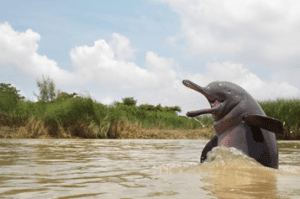TAG: GS 3: ECOLOGY AND ENVIRONMENT
THE CONTEXT: A recent study conducted by scientists from the Wildlife Institute of India and the National Mission for Clean Ganga assessed the distribution, numbers, and habitat suitability of the Gangetic dolphin across the Ganga basin.
EXPLANATION:
- This study, conducted during the post-monsoon seasons of 2022 and 2023, covered a total linear stretch of 1,290 km, focusing on the tributaries and sub-tributaries of the Ganga River.
- The study found that the Gangetic dolphin inhabits most tributaries and sub-tributaries of the Ganga, underscoring the importance of these smaller rivers as refuges for aquatic macrofauna.
- Scientists have identified 620 km of smaller rivers in the Ganga basin as priority conservation areas.
- These rivers harbor more than 15% of the Gangetic dolphin population, contributing to habitat diversity and ecological resilience.
Conservation Challenges
- The conservation of the Gangetic dolphin faces several challenges:
- Habitat Fragmentation: Construction of dams and barrages disrupts river flow and water availability.
- Pollution: Agricultural runoff containing pesticides and other chemicals, along with increased sediment deposition from deforestation, adversely impacts the species.
- Climate Change: Changes in climate exacerbate the challenges of maintaining suitable habitats.
- Human Activities: Directed and unintentional killings, coupled with rising mechanized boat traffic, further threaten the dolphins.
- The study builds on recommendations from 2022 for basin-wide conservation initiatives.
- Key measures include:
- Habitat Protection and Restoration: Ensuring ecological flow in rivers and increasing the number of protected areas for dolphins.
- Threat Mitigation: Implementing technological interventions to reduce accidental dolphin deaths and managing fisheries to avoid overfishing and net entanglement.
- Community Engagement and Awareness: Raising awareness among local communities and involving them in conservation efforts.
- Research and Monitoring: Conducting systematic surveys and scientific monitoring to track population trends and health.
- Policy and Collaboration: Engaging with government agencies, NGOs, and local communities to implement and sustain conservation measures.
Habitat Mapping and Population Monitoring
- The study provided new data on the species’ habitat, revealing the population status in smaller rivers such as Rapti, Babai, and Bagmati.
- This information is crucial for understanding dolphin trends across river networks and at the metapopulation level.
- Environmental factors such as river channel geomorphology and human-induced stresses were identified as affecting dolphin presence.
Cooperative Efforts and Long-Term Sustainability
- Effective conservation requires cooperative efforts and significant funding.
- Experts emphasize the need for ground-level interventions and long-term commitment.
- Conservation programs must be tailored to local conditions, involving robust scientific monitoring and objective evaluation to measure impacts.
- Building social trust and equity among river-dependent communities is essential.
Gangetic dolphin
- The Gangetic dolphin (Platanista gangetica), endemic to the Ganga River, plays a crucial role in maintaining the river’s ecosystem.
- Ganges river dolphins live in the Ganges-Brahmaputra-Meghna and Karnaphuli-Sangu river systems of Nepal, India, and Bangladesh.
- The Ganges river dolphin can only live in freshwater and is essentially blind.
- They hunt by emitting ultrasonic sounds, which bounces off of fish and other prey, enabling them to “see” an image in their mind. They are also called ‘susu’.
- Despite its ecological importance, the species faces significant threats that have led to a decline in its population.
- The Gangetic dolphin is essential for regulating the energy flow within the river ecosystem and maintaining the populations of fish and crustaceans.
- Its presence indicates a healthy river system.
- However, its population has dwindled to an estimated 2,500 to 5,000 individuals, with the species listed as endangered by the International Union for Conservation of Nature (IUCN).
- It is a Schedule I animal under the Wildlife (Protection) Act, 1972, and has been classified as an endangered species by the International Union for Conservation of Nature.


